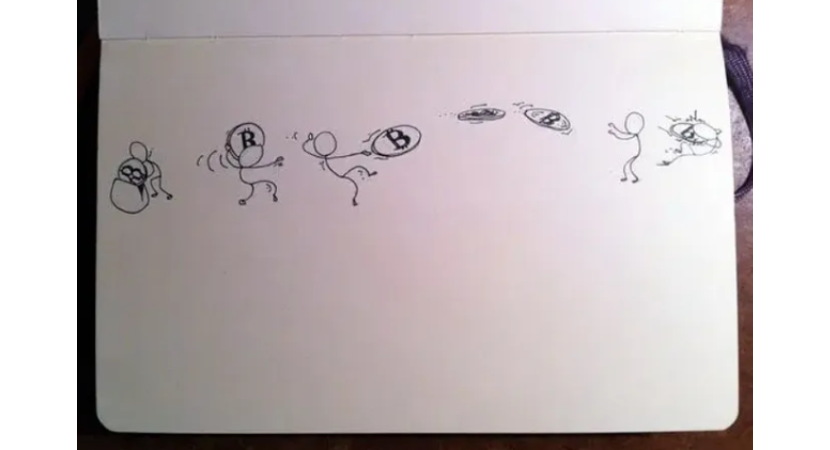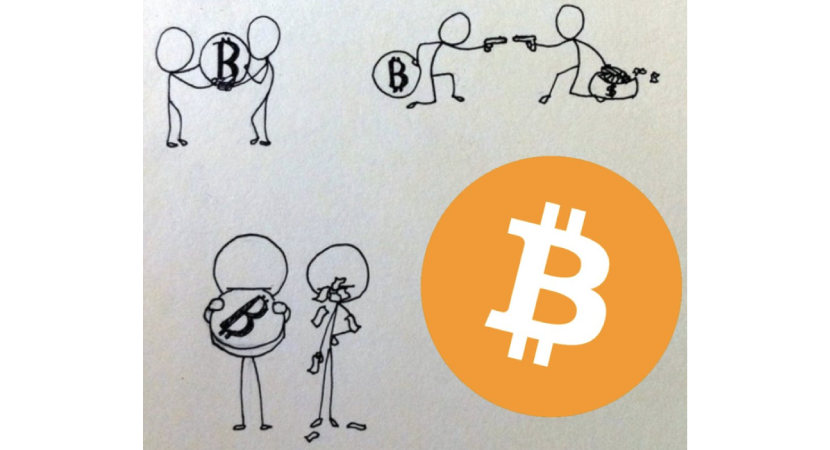Of all the Bitcoin legends, one stands out as being a humble and seemingly decent guy. Andrey Petrov, aka Shazow Bitcoin, is a software developer and artist who was offering to draw stick-figure sketches back in 2010, accepting Bitcoin in return and accumulating over 55 BTC when its value was approximately $0.50 per coin, which would be worth more than $5 million in today’s money. He’s also a respected coder who contributed to several open-source projects, notably developing btc-crawl, a Bitcoin node network crawler, an arbitrage bot named liquid and the widely used Python HTTP library, urllib3.In this article, we’re going to take a look at Shazow’s life and explore how much he added to the crypto and software communities over the years.
Shazow – Bitcoin Early Adopter & Pioneer
Canadian national Andrey Petrov, or Shazow as the Bitcoin community knows him, stumbled into his legendary status almost by accident.It all kicked off back in 2011 when someone on well-known crypto forum Bitcointalk asked him to sketch a stick figure sending bitcoins. That single drawing earned him 1 BTC, which at the time was worth around $0.50. It was pocket change. But little did Shazow know, Bitcoin was about to take off on its first bull run.

As word spread about Shazow's quirky art, requests started pouring in. People were starting to get interested in Bitcoin, and Andrey’s art captured the playful, yet revolutionary spirit of the community.Over time, as demand for his art grew, Shazow upgraded his work from stick figures to more polished vector illustrations, which allowed him to charge more. It’s wild to think a few sketches could turn into a fortune, but that’s the magic of catching a revolutionary wave like Bitcoin at the right moment.

At one point, Shazow made more than 21 BTC in a single week from selling his art. He ended up creating more than 55 BTC worth of drawings in just a few weeks.One of Shazow’s most famous drawings depicts Satoshi Nakamoto in a gunfight with Ben Bernanke (then chair of the Federal Reserve) which earned him 2.14 BTC ($200,000+ in today’s money).

As interest in crypto spread like wildfire triggering a bull run, by 2013 Bitcoin prices had jumped to more than $30, meaning Andrey saw a staggering 3,502% profit on his initial earnings. Within a couple of years Shazow’s stash was worth $100,000’s. At today’s prices 55 BTC would be worth roughly $5 million! It’s believed that he still HODLs (holds on for dear life) to some of the Bitcoin he made, but his wallet transactions show that he sold or moved more than $1.5 million worth of it in 2017 and 2018. This shows Petrov’s foresight to hold onto his BTC rather than sell it all off after the first major bull run in 2012.Some of Shazow’s Bitcoin art masterpieces include funny pictures of well-known Bitcoin developer Gavin Andresen, such as the one below showing him setting fire to a pile of cash with a flame-thrower, titled “The Gavinator”!

Shazow on Bitcointalk
Andrey Petrov, aka Shazow, was one of the early members of the legendary forum Bitcointalk.org, which is still active today. He was only active on the forum for a few months in 2011, but made quite an impact, as you’ll find out in a moment. Below, you’ll see one of his first Bitcointalk posts, offering a stick figure drawing service in exchange for Bitcoin payments.

As the idea catches on and people see Shazow’s amusing cartoons, other members suggest that he turns it into a regular reader-funded comic.

Shazow’s humility makes him a well-liked figure in the forums, as the post below shows, where Petrov says he’s “no Randall Munroe when it comes to writing geeky humour. Best I’ve mastered is tweets. ”

The forum post below shows just how much of the early days of Bitcoin were based on trust. Shazow is happy to draw first and get paid later, simply requesting that other members don’t forget to pay for the commission to keep him motivated.

Some members even express an interest in hiring Petrov on a weekly retainer contract. Here at Plasbit, we’re not sure if any of these offers came to fruition as we haven’t seen any posts that prove they did.

Later on, as BTC starts to fluctuate in value, Petrov adjusts his pricing accordingly, asking for 2 BTC for an ink draft and 5 BTC on top of them for a digital vector version.

Some More of Shazow’s Bitcoin Drawings
In this section, we’re going to look at some of the most famous Shazow Bitcoin drawings and how they were commissioned.The picture below shows a “cyborg crypto-anarchist riding an alpaca” that one forum user requested in return for 2.13 Bitcoin. The “A3” symbol on the flag stands for Assessment, Assembly, and Action, which was the motto of cypherpunks, an early crypto movement intent on changing the world through decentralized finance.

As things progressed, Petrov took on more complex drawings by commission, like the one below, which tries to explain the cryptography behind Bitcoin in a quirky and funny way.

The drawing below was one of Shazow’s highest earning Bitcoin commissions, netting him a whopping 5 BTC, an incredible $460,600 at today’s prices! It depicts Bitcoin enthusiasts as a bunch of underground freedom fighters taking on the might of the state and traditional banking.

When asked to draw a vision of how Bitcoin and traditional fiat currency might live together in harmony one day, Shazow produced the picture shown below, earning him 2 BTC in total.

Petrov didn’t only produce sketches related to Bitcoin. One of his highest paying commissions was a logo or poster for a band called Velorio, who are still playing today by all accounts. This picture earned Shazow 20 BTC, which would be equal to almost $2 million today!

What Can We Learn from The Shazow Bitcoin Story?
It’s hard not to be impressed when you read Petrov’s story. He took the initiative early on and offered some funny drawings in return for Bitcoin that was worth peanuts back then. But was Shazow just lucky? Or did he see the potential of Bitcoin and run with it? We’ll never know for sure. You could say Shazow had a bit of luck on his side. He stumbled into Bitcoin early on when most people dismissed it as a niche idea that would probably amount to nothing. But luck isn’t the whole story. What stands out is Petrov’s entrepreneurial spirit. Instead of just lurking on forums or speculating about Bitcoin’s potential, he jumped in and offered something concrete in the form of quirky, stick-figure drawings. It was a creative, low-risk way to engage with the community and experiment with Bitcoin as a currency. His work tapped into the playful and revolutionary spirit of early Bitcoin culture.
Here at Plasbit, we think that yes – luck played a part in Shazow’s Bitcoin success. But they say you make your own luck in life and by being proactive and channeling his energy into something creative, that’s just what Shazow did. Although he wasn’t there right at the beginning, i.e. in 2009 when Bitcoin’s first transaction took place, he joined shortly afterwards in 2011. At first, it seems like he treated Bitcoin as an experiment, simply a way to try something new and connect with like-minded people. Over time, as he saw Bitcoin’s value rise and demand for his art grow, he probably started to see its long-term potential. It’s unlikely that Petrov or anyone else involved in the Bitcointalk community at the time foresaw Bitcoin reaching today’s astronomical prices, but his decision to hold onto some of his earnings until at least 2018 shows he understood its promise. He might still be HODLing onto a nice little stash today – nobody except Petrov knows for sure.
Were Shazow’s Bitcoin Drawings Art or Business?
It’s an interesting question to ponder. His drawings certainly don’t fit the traditional definition of “art,” but they clearly resonated with the Bitcoin community at the time and have turned into Bitcoin history artefacts. Pieces like “The Gavinator” and the Satoshi vs. Bernanke gunfight were almost like symbols of the cypherpunk movement. However, Shazow’s ability to scale his work (even if only over a short period of time), adjust pricing based on Bitcoin’s value, and even consider retainer contracts shows a business side to his thinking. At Plasbit, we would say that his venture was a bit of both – artistic and entrepreneurial. What can we take from the Shazow Bitcoin art story? The biggest lesson is to take action and get involved in new projects. This applies to the whole crypto community. You can’t just sit around waiting for something to happen. Take an active role. Offer a service. Share an idea. Join a new movement. The important thing is to simply participate. You might not get the same results as Shazow, but it doesn’t matter. He didn’t wait for the perfect moment or overthink his plan, he just started sketching and let things grow from there. Here’s how you can channel some of your energy into the crypto community.
- Engage with New Projects & Movements: Keep an eye on new tech or communities that excite you. Aim to be an early adopter, like Shazow, as it might open unexpected doors.
- Offer Value, No Matter How Small: Even a simple idea, such as stick-figure drawings, can resonate if it taps into something bigger and becomes symbolic.
- Adapt and Scale: As demand for Shazow’s Bitcoin art grew, he refined his style and upped his prices.
- Build Trust and Be Trustworthy: The early Bitcoin community operated on trust, and Shazow’s willingness to draw first and get paid later made him a respected figure.
Shazow’s story is a reminder that success can come from a mixture of good timing, creativity, and action. He didn’t set out to become a Bitcoin legend, but his willingness to take a chance on something new made all the difference.
A Brief History of Crypto Art
It’s likely that people will look back on the cultural history of the last decade through the lens of crypto, as the community has spawned new forms of art, such as NFTs (non-fungible tokens). The seeds of crypto art were planted as early as 1993, when renowned computer scientist and cypherpunk Hal Finney envisioned digital collectible trading cards, a concept very similar to today’s NFTs. In 2010, Herbert R. Sim created one of the first artistic tributes to Bitcoin with his Satoshi Samurai drawing, blending art with crypto culture.

Not long after, NameCoin was released, which was a blockchain that introduced non-fungible digital assets through unique Punycode domain experiments and creative ASCII art. The journey from the concept to actual crypto art began with projects like Casascius Coins in 2011 which were physical Bitcoins that had embedded private keys.

In 2013, artist Kevin Abosch’s book Bank declared that paired Bitcoin keys should be considered as artistic creations. This started to bridge the gap between traditional and crypto art forms. By 2014, blockchain-based marketplaces like Monegraph allowed artists to certify digital images as unique and scarce, laying the foundation for today’s NFT platforms. Around the same time, several artists began experimenting with blockchain-themed installations, such as Peter Frölich’s Bitcoin mining rig in an antique frame.

Projects like Rare Pepes in 2016 and CryptoPunks in 2017 made big waves in the crypto community with tokenized collectibles. CryptoPunks used a 1980’s throwback, 8-bit aesthetic, which quickly became a blueprint for other NFT collections.

By the early 2020’s, the world of crypto art was hitting the mainstream media with record-breaking NFT sales, such as “Beeple’s Everydays: The First 5000 Days” which sold at auction for a mind-boggling $69 million. Platforms and marketplaces like OpenSea, Rarible, and SuperRare have since made crypto art even more popular and mainstream. Today, crypto art continues to evolve with programmable art platforms, immersive virtual galleries, and AI-generated art. The integration of art with decentralized finance (DeFi) and the metaverse further blurs the boundaries between technology and creativity.
What Is Andrey Petrov (Shazow) Bitcoin Artist and Developer Doing Now?
Since his early involvement with the crypto community back in 2011, Petrov went quiet for a number of years. In that time, Petrov made a name for himself as an accomplished software developer and open-source contributor based in Toronto. Still using the handle “Shazow”, Petrov has been very active on Github, with almost 700 contributions over the past year, of which 84% were commits, including adding new features and helping to fix bugs.
urllib3
Petrov was the brains behind the user-friendly HTTP public client library for Python, urllib3, which has been starred 3,800 times and forked 1,200 times. On GitHub, a "star" is like giving a project a thumbs-up or bookmarking it. It’s a way for developers to show appreciation or indicate that they find the project useful and want to keep track of it. So, 3,800 stars mean that a lot of developers think urllib3 is worth paying attention to. Forking on GitHub means copying the project’s code into your own repository. Developers might fork a project to experiment, make custom changes, or even contribute improvements back to the original project. So, 1,200 forks show that many developers find urllib3’s code important enough to work on or build upon. Urllib3 stands out as a reliable power tool for handling HTTP requests in Python, featuring:
- Connection pooling: Reuses connections instead of opening a new one each time, which speeds things up and reduces overhead.
- Thread safety: If you’re running multiple tasks at once, it doesn’t freak out. Everything is kept tidy and synchronized.
- Retries: If a request fails temporarily, urllib3 automatically tries again for you.
- Secure by default: Handles SSL/TLS connections for safer, encrypted communications.
ssh-chat
Petrov also developed ssh-chat, a Github repository that has received 5,600 stars and more than 400 forks. Ssh-chat is a chat server that runs over SSH, which stands for Secure Shell, a protocol mainly used to securely access servers. You connect to the chat server using an SSH client, the same tool you’d use to log into a remote server. But instead of getting a command-line interface, you’re dropped into a chatroom. As it uses SSH, the chat is encrypted, making it secure right away, without the need for extra encryption layers. You don’t need to use extra apps or plugins, simply use an SSH client, which is already built into most operating systems. Other users can join the chat by connecting to the server’s SSH address. It supports usernames based on SSH keys which means people are uniquely identified by their cryptographic keys. There are also a few admin features built in, such as the ability to ban users or moderate the chat. Ssh-chat has become popular with tech communities or teams who want a simple, secure chat system without relying on third-party apps. It’s also a fun, minimalist experiment for tech types who enjoy playing around with command-line tools.
whatsabi
In recent years, Shazow seems to have turned his attention back to crypto and blockchain, with a recent tool called “whatsabi”. Whatsabi analyzes Ethereum bytecode and deduces important information like the ABI (Application Binary Interface) of a smart contract, even when the source code isn’t available Often, the source code of smart contracts isn’t publicly verified, making it hard to interact with or analyze them. That’s where WhatsABI steps in and does the following steps.
- Extracts ABIs: The ABI is like a blueprint that tells you what functions and events a contract has and how to interact with them. WhatsABI reverse-engineers this from the bytecode.
- Detects Proxies: Figures out if a contract is using a proxy (a kind of "middleman" contract that forwards calls to another contract) and resolves where that proxy is pointing.
- Database Integration: Works with public databases like Etherscan and Sourcify to enhance its analysis, looking up function signatures and other metadata.
- Works Without Source Code: Doesn’t rely on the original programming language, so it works for contracts written in Solidity, Vyper, or even raw assembly.
In other words, whatsABI simplifies the whole process by turning raw bytecode into human-readable information. This makes it popular with:
- Developers building wallets, frontends, or blockchain explorers.
- Researchers conducting bytecode analysis.
- Security experts investigating unverified or suspicious contracts.
The whatsABI library is small enough to run in browsers or embed in wallets and uses algorithms that scale well with complex contracts, so it doesn’t time out or hog resources. It was released under the MIT license, so anyone can use or contribute to the project. So far whatsabi has been used by a variety of projects, including block explorers like Otterscan, developer tools like Rivet, and security platforms like savvy.
The Legacy of Shazow Bitcoin Artist and Coder
Andrey Petrov, better known as Shazow, epitomizes the spirit of the early Bitcoin and crypto communities. There was a spirit of creativity, innovation, and fearlessness. His stick-figure sketches were more than just a way to earn Bitcoin. They symbolized the cypherpunk and crypto movement that would soon revolutionize finance, art, and tech. Shazow later developed impactful tools like urllib3, ssh-chat, and whatsabi. It’s no exaggeration to say that he has made a big and lasting impact on the world of crypto and software development, and there’s probably more to come. At Plasbit, we applaud Andrey Petrov’s artistic and entrepreneurial spirit and we hope that it inspires you to go and become a proactive participant in the crypto community.







